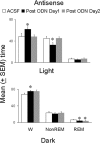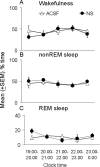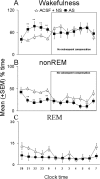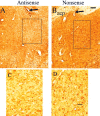A1 receptor and adenosinergic homeostatic regulation of sleep-wakefulness: effects of antisense to the A1 receptor in the cholinergic basal forebrain
- PMID: 12764116
- PMCID: PMC2002519
- DOI: 10.1523/JNEUROSCI.23-10-04278.2003
A1 receptor and adenosinergic homeostatic regulation of sleep-wakefulness: effects of antisense to the A1 receptor in the cholinergic basal forebrain
Abstract
We hypothesized that adenosine, acting via the A1 receptor, is a key factor in the homeostatic control of sleep. The increase in extracellular levels of adenosine during prolonged wakefulness is thought to facilitate the transition to sleep by reducing the discharge activity of wakefulness-promoting neurons in the basal forebrain. Adenosine A1 receptor control of the homeostatic regulation of sleep was tested by microdialysis perfusion of antisense oligonucleotides against the mRNA of the A1 receptor in the magnocellular cholinergic region of the basal forebrain of freely behaving rats. After microdialysis perfusion of A1 receptor antisense in the basal forebrain, spontaneous levels of sleep-wakefulness showed a significant reduction in non-rapid eye movement (REM) sleep with an increase in wakefulness. After 6 hr of sleep deprivation, the antisense-treated animals spent a significantly reduced amount of time in non-REM sleep, with postdeprivation recovery sleep hours 2-5 showing a reduction of approximately 50-60%. There was an even greater postdeprivation reduction in delta power (60-75%) and a concomitant increase in wakefulness. All behavioral state changes returned to control (baseline) values after the cessation of antisense administration. Control experiments with microdialysis perfusion of nonsense (randomized antisense) oligonucleotides and with artificial CSF showed no effect during postdeprivation recovery sleep or spontaneously occurring behavioral states. Antisense to the A1 receptor suppressed A1 receptor immunoreactivity but did not show any neurotoxicity as visualized by Fluoro-Jade staining. These data support our hypothesis that adenosine, acting via the A1 receptor, in the basal forebrain is a key component in the homeostatic regulation of sleep.
Figures







Similar articles
-
Adenosinergic modulation of basal forebrain and preoptic/anterior hypothalamic neuronal activity in the control of behavioral state.Behav Brain Res. 2000 Nov;115(2):183-204. doi: 10.1016/s0166-4328(00)00258-8. Behav Brain Res. 2000. PMID: 11000420
-
Adenosinergic inhibition of basal forebrain wakefulness-active neurons: a simultaneous unit recording and microdialysis study in freely behaving cats.Neuroscience. 2003;122(4):1107-13. doi: 10.1016/j.neuroscience.2003.08.006. Neuroscience. 2003. PMID: 14643776
-
Microdialysis perfusion of orexin-A in the basal forebrain increases wakefulness in freely behaving rats.Arch Ital Biol. 2001 Apr;139(3):313-28. Arch Ital Biol. 2001. PMID: 11330208
-
Adenosine and sleep-wake regulation.Prog Neurobiol. 2004 Aug;73(6):379-96. doi: 10.1016/j.pneurobio.2004.06.004. Prog Neurobiol. 2004. PMID: 15313333 Review.
-
[Adenosine in sleep regulation].Rev Neurol (Paris). 2001 Nov;157(11 Pt 2):S7-11. Rev Neurol (Paris). 2001. PMID: 11924043 Review. French.
Cited by
-
Sleep Promoting Effect of Luteolin in Mice via Adenosine A1 and A2A Receptors.Biomol Ther (Seoul). 2019 Nov 1;27(6):584-590. doi: 10.4062/biomolther.2019.149. Biomol Ther (Seoul). 2019. PMID: 31646844 Free PMC article.
-
Acute binge alcohol administration reverses sleep-wake cycle in Sprague Dawley rats.Alcohol Clin Exp Res. 2014 Jul;38(7):1941-6. doi: 10.1111/acer.12463. Epub 2014 Jun 13. Alcohol Clin Exp Res. 2014. PMID: 24930893 Free PMC article.
-
Effects of adenosine receptor overexpression and silencing in neurons and glial cells on lifespan, fitness, and sleep of Drosophila melanogaster.Exp Brain Res. 2023 Jul;241(7):1887-1904. doi: 10.1007/s00221-023-06649-y. Epub 2023 Jun 19. Exp Brain Res. 2023. PMID: 37335362 Free PMC article.
-
Reduced impact of alcohol use on next-day tiredness in older relative to younger adults: A role for sleep duration.Psychol Aging. 2017 Nov;32(7):642-653. doi: 10.1037/pag0000198. Epub 2017 Oct 12. Psychol Aging. 2017. PMID: 29022725 Free PMC article.
-
Integrative sleep management: from molecular pathways to conventional and herbal treatments.Naunyn Schmiedebergs Arch Pharmacol. 2025 May 8. doi: 10.1007/s00210-025-04183-y. Online ahead of print. Naunyn Schmiedebergs Arch Pharmacol. 2025. PMID: 40338321 Review.
References
-
- Basheer R, Rainnie DG, Porkka-Heiskanen T, Ramesh V, McCarley RW ( 2001a) Adenosine, prolonged wakefulness, and A1-activated NF-kB DNA binding in the basal forebrain of the rat. Neuroscience 104: 731–739. - PubMed
-
- Basheer R, Halldner L, Alanko L, McCarley RW, Fredholm BB, Porkka-Heiskanen T ( 2001b) Opposite changes in adenosine A1 and A2A receptor mRNA in the rat following sleep deprivation. NeuroReport 12: 1577–1580. - PubMed
-
- Biggs TA, Myers RD ( 1997) Adenosine A1 receptor antisense infused in striatum of rats: actions on alcohol-induced locomotor impairment, blood alcohol, and body temperature. Alcohol 14: 617–621. - PubMed
Publication types
MeSH terms
Substances
Grants and funding
LinkOut - more resources
Full Text Sources
Other Literature Sources
